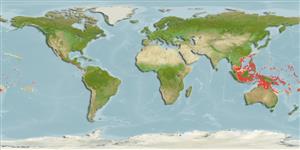Common names from other countries
Environment: milieu / climate zone / depth range / distribution range
Ecologia
marinhas associadas(os) a recifes; não migratória; intervalo de profundidade 3 - 70 m (Ref. 4859). Tropical; 30°N - 23°S
Western Pacific: Ryukyu Islands to Indonesia, the Solomon Islands, the Great Barrier Reef and New Caledonia (Ref. 48391). Palau and Kapingamarangi in Micronesia (Ref. 1602).
Tamanho / Peso / Idade
Maturity: Lm ? range ? - ? cm
Max length : 10.0 cm TL macho/indeterminado; (Ref. 48636)
Espinhos dorsais (total) : 14 - 15; Raios dorsais moles (total) : 16 - 17; Espinhos anais: 3; Raios anais moles: 16 - 17.
Common in coral-rich areas of outer reef slopes, occasionally sighted in lagoons and passages. Prefers habitats with rich mixed invertebrate growth (Ref. 48636). Usually seen singly or in pairs. It thrives well in an algae-grown tank (Ref. 4859). Feeds on algae. Forms harems of 3-7 individuals. Frequently exported through the aquarium trade (Ref. 48391).
Life cycle and mating behavior
Maturities | Reprodução | Spawnings | Egg(s) | Fecundities | Larvas
Steene, R.C., 1978. Butterfly and angelfishes of the world. A.H. & A.W. Reed Pty Ltd., Australia. vol. 1. 144 p. (Ref. 4859)
Categoria na Lista Vermelha da IUCN (Ref. 130435)
CITES (Ref. 128078)
Not Evaluated
Ameaça para o homem
Harmless
Utilização humana
Pescarias: espécies comerciais; Aquário: Espécies comerciais
Ferramentas
Relatórios especiais
Descarregue XML
Fontes da internet
Estimates based on models
Preferred temperature (Ref.
115969): 26.3 - 29, mean 28 (based on 520 cells).
Phylogenetic diversity index (Ref.
82804): PD
50 = 0.5000 [Uniqueness, from 0.5 = low to 2.0 = high].
Bayesian length-weight: a=0.03090 (0.01359 - 0.07026), b=2.89 (2.70 - 3.08), in cm Total Length, based on LWR estimates for this (Sub)family-body shape (Ref.
93245).
Nível Trófico (Ref.
69278): 2.8 ±0.29 se; based on food items.
Resiliência (Ref.
120179): Elevada, tempo mínimo de duplicação da população menor que 15 meses (Preliminary K or Fecundity.).
Fishing Vulnerability (Ref.
59153): Low vulnerability (10 of 100).
